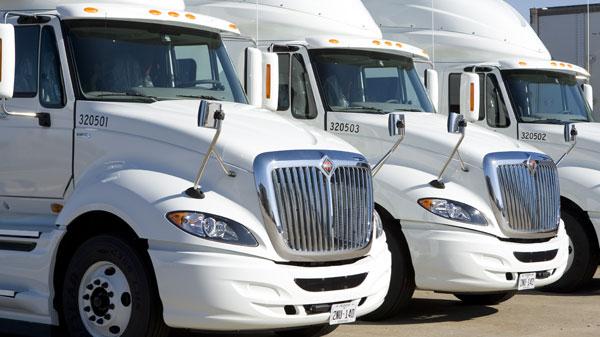With a semi truck costing $100,000 and a top-end expediting class 8 truck costing twice that, one does not make the decision to buy a new truck to replace the old one for no reason. While in semi trucks, many owner operators keep their trucks longer,and companies and fleets usually trade when the warrantees run out. Or that is what they did until the current economic downturn.
Expediting is different. With just-in-time freight being so fragile many times and the scheduling so tight, most expedite freight cannot be transferred to another truck in case of break down. Therefore, vehicle reliability is tantamount in an expedite owner’s mind.
According to Wes Hearn, salesman at Middle Georgia Freightliner, the expediting world works on a five year/seven year rule of thumb: five years for class 7 trucks and seven years on class 8 trucks before the truck needs replaced. However, that is not a hard and fast rule; it differs at some companies. Many expedite companies visually inspect class 7 vehicles yearly to make sure they are road worthy. Class 8 trucks are usually three or four years old before the yearly inspections are started. There is no “do over” in expediting; too many service failures equals lease termination.
The main reason to trade or sell a truck is mechanical soundness. Mechanical failure equals downtime, and while the costs of the repairs are tax deductible, there is no way those deductions will cover the cost of the working time lost or the cost to an owner operator’s or driver/contractor’s reputation with the company. There is no rule of thumb governing the amount of repair one should do to a truck before considering selling it as ‘worn out’ or ‘unreliable’. It depends on the owner’s bottom line and what type of repairs are being done. Normal maintenance and tires are is reasonable to owners because these things can be planned for. However, if the truck sits on the shoulder of the road more than once, then most owners will consider trading or selling it.
Depreciation schedules also are a reason to put your truck on the market or trade it. The standard depreciation on semis or commercial trucks is three years. There is some question among owner operators whether it is valid to buy a new truck to take advantage of depreciation tax deductions. Some feel that the deduction does not offset the price of the new truck payments, and that running the truck out of depreciation and using maintenance deductions is the better course until the truck is older. The best thing in most people’s opinion is to have a good tax consultant and be guided by them.
TO SELL OR TRADE
There are pros and cons to both options. Owners who contract the trucks out to drivers, or hire drivers to drive them, might choose to sell their old equipment instead of trading it in. This is due to the non-driving owner having the time to deal with selling the truck, i.e. advertising, meeting prospective buyers etc. While the money made from selling outright instead of trading might be greater, it takes time that few have. A driving owner operator is too busy working on the road to deal with selling the old truck outright. Then there is the capital gains aspect. In trade, the trade in value does not affect capital gains. In selling outright, unless the money received is used as down payment, there may be capital gains tax due on the price received.
Most owners opt to trade in a truck if it is to be retired. While the ease of trading the old truck in makes getting rid of the used truck better, if that truck is not paid off, then the note on the new truck may be larger to cover the old loan.
UPGRADING
The final reason to get rid of one truck and buy another is when one wants to upgrade into another type of expediting, perhaps from sprinter to class 7 with a sleeper to go over the road. This decision must be made carefully considering first the difference in cost of the equipment itself. A new sprinter, less the securement additions, might cost $35-40,000. A new class 7 truck with sleeper and reefer box can cost $250,000 with all of the bells and whistles. Secondly, the class 7 will require a class B CDL usually with hazmat endorsements and other skills.
The main consideration after the money is to find a dealership experienced in expediting talk to about spec’ing the class 7, and decide what company one will lease on with (if different from the one worked at with the sprinter). The dealership will be able to tell what the sprinter is worth in trade or outright sale and what the payments on the class 7 will be. Doing one’s homework is important to one’s success.
Nothing is easy in trucking, not the job, keeping the equipment up, or deciding to sell, trade, or upgrade. Get advice from the professionals in your life, your tax consultant, your dealership and your carrier before making the final decision on whether to trade, sell, upgrade, or keep the truck you have.
